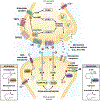Cannabinoids and the Gastrointestinal Tract
- PMID: 37678488
- PMCID: PMC10872845
- DOI: 10.1016/j.cgh.2023.07.031
Cannabinoids and the Gastrointestinal Tract
Abstract
The synthesis and degradation of endocannabinoids, location of cannabinoid (CB) receptors, and cannabinoid mechanisms of action on immune/inflammatory, neuromuscular, and sensory functions in digestive organs are well documented. CB2 mechanisms are particularly relevant in immune and sensory functions. Increasing use of cannabinoids in the United States is impacted by social determinants of health including racial discrimination, which is associated with tobacco and cannabis co-use, and combined use disorders. Several conditions associated with emesis are related to cannabinoid use, including cannabinoid hyperemesis or withdrawal, cyclic vomiting syndrome, and nausea and vomiting of pregnancy. Cannabinoids generally inhibit gastrointestinal motor function; yet they relieve symptoms in patients with gastroparesis and diverse nausea syndromes. Cannabinoid effects on inflammatory mechanisms have shown promise in relatively small placebo-controlled studies in reducing disease activity and abdominal pain in patients with inflammatory bowel disease. Cannabinoids have been studied in disorders of motility, pain, and disorders of gut-brain interaction. The CB2-receptor agonist, cannabidiol, reduced the total Gastroparesis Cardinal Symptom Index and increases the ability to tolerate a meal in patients with gastroparesis appraised over 4 weeks of treatment. In contrast, predominant-pain end points in functional dyspepsia with normal gastric emptying were not improved significantly with cannabidiol. The CB2 agonist, olorinab, reduced abdominal pain in inflammatory bowel disease in an open-label trial and in constipation-predominant irritable bowel syndrome in a placebo-controlled trial. Cannabinoid mechanisms alter inflammation in pancreatic and liver diseases. In conclusion, cannabinoids, particularly agents affecting CB2 mechanisms, have potential for inflammatory, gastroparesis, and pain disorders; however, the trials require replication and further understanding of risk-benefit to enhance use of cannabinoids in gastrointestinal diseases.
Keywords: Cannabis; Gastroparesis; Inflammatory Bowel Diseases; Nausea; Pain Disorders; Vomiting.
Copyright © 2023 AGA Institute. Published by Elsevier Inc. All rights reserved.
Conflict of interest statement
Figures


Similar articles
-
Pharmacology, Clinical Effects, and Therapeutic Potential of Cannabinoids for Gastrointestinal and Liver Diseases.Clin Gastroenterol Hepatol. 2021 Sep;19(9):1748-1758.e2. doi: 10.1016/j.cgh.2020.04.020. Epub 2020 Jul 13. Clin Gastroenterol Hepatol. 2021. PMID: 32673642 Free PMC article. Review.
-
Role of cannabis in digestive disorders.Eur J Gastroenterol Hepatol. 2017 Feb;29(2):135-143. doi: 10.1097/MEG.0000000000000779. Eur J Gastroenterol Hepatol. 2017. PMID: 27792038 Review.
-
The role of cannabinoids in regulation of nausea and vomiting, and visceral pain.Curr Gastroenterol Rep. 2015 Feb;17(2):429. doi: 10.1007/s11894-015-0429-1. Curr Gastroenterol Rep. 2015. PMID: 25715910 Review.
-
Worldwide prevalence and burden of gastroparesis-like symptoms as defined by the United European Gastroenterology (UEG) and European Society for Neurogastroenterology and Motility (ESNM) consensus on gastroparesis.United European Gastroenterol J. 2022 Oct;10(8):888-897. doi: 10.1002/ueg2.12289. Epub 2022 Aug 19. United European Gastroenterol J. 2022. PMID: 35985672 Free PMC article.
-
A Randomized, Controlled Trial of Efficacy and Safety of Cannabidiol in Idiopathic and Diabetic Gastroparesis.Clin Gastroenterol Hepatol. 2023 Dec;21(13):3405-3414.e4. doi: 10.1016/j.cgh.2023.07.008. Epub 2023 Jul 22. Clin Gastroenterol Hepatol. 2023. PMID: 37482172 Free PMC article. Clinical Trial.
Cited by
-
Obesity-associated inflammation countered by a Mediterranean diet: the role of gut-derived metabolites.Front Nutr. 2024 Jun 24;11:1392666. doi: 10.3389/fnut.2024.1392666. eCollection 2024. Front Nutr. 2024. PMID: 38978699 Free PMC article. Review.
-
The Role of Endocannabinoids in Physiological Processes and Disease Pathology: A Comprehensive Review.J Clin Med. 2025 Apr 21;14(8):2851. doi: 10.3390/jcm14082851. J Clin Med. 2025. PMID: 40283681 Free PMC article. Review.
-
Electroacupuncture improves low-grade duodenal inflammation in FD rats by reshaping intestinal flora through the NF-κB p65/NLRP3 pyroptosis pathway.Heliyon. 2024 May 16;10(10):e31197. doi: 10.1016/j.heliyon.2024.e31197. eCollection 2024 May 30. Heliyon. 2024. PMID: 38807876 Free PMC article.
-
Medicinal Cannabis and the Intestinal Microbiome.Pharmaceuticals (Basel). 2024 Dec 17;17(12):1702. doi: 10.3390/ph17121702. Pharmaceuticals (Basel). 2024. PMID: 39770543 Free PMC article. Review.
-
Dopamine, activation of ingestion and evaluation of response efficacy: a focus on the within-session time-course of licking burst number.Psychopharmacology (Berl). 2024 Jun;241(6):1111-1124. doi: 10.1007/s00213-024-06600-1. Epub 2024 May 4. Psychopharmacology (Berl). 2024. PMID: 38702473 Free PMC article. Review.
References
-
- Cannabis. Alcohol, drugs and addictive behaviours unit. World Health Organization. 2022. https://www.who.int/teams/mental-health-and-substance-use/alcohol-drugs-....
-
- Whiting PF, Wolff RF, Deshpande S, et al. Cannabinoids for medical use: a systematic review and meta-analysis. JAMA 2015;313:2456–2473. - PubMed
-
- Meng H, Johnston B, Englesakis M, et al. Selective cannabinoids for chronic neuropathic pain: a systematic review and meta-analysis. Anesth Analg 2017;125:1638–1652. - PubMed
-
- Tait RJ, Caldicott D, Mountain D, et al. A systematic review of adverse events arising from the use of synthetic cannabinoids and their associated treatment. Clin Toxicol 2016;54:1–13. - PubMed
Publication types
MeSH terms
Substances
Grants and funding
LinkOut - more resources
Full Text Sources

